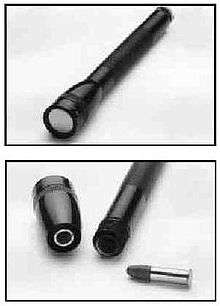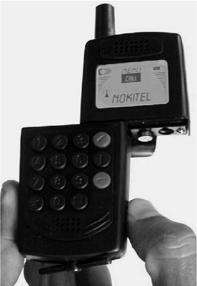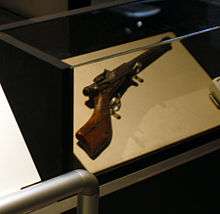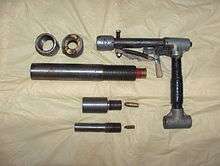Improvised firearm

An improvised firearm is a firearm manufactured other than by a firearms manufacturer or a gunsmith, and is typically constructed by adapting existing materials to the purpose. They range in quality from crude weapons that are as much a danger to the user as the target, to high-quality arms produced by cottage industries using salvaged and repurposed materials.[1][2][3]
Improvised firearms are commonly used as tools by criminals and insurgents and are often associated with such groups;[4][5] other uses include self-defense in lawless areas and hunting game in poor rural areas.[6]
Construction


The essential part of any improvised firearm is the barrel and chamber. For small, low-pressure cartridges, like the common .22 caliber (5.5 mm) rimfire cartridges, even very thin-walled tubing will suffice. Author Harlan Ellison describes the zip guns used by gangs in 1950s New York City as being made from tubing used in coffee percolators or automobile radio antennas, strapped to a block of wood to serve as a handle. A rubber band provided the power for the firing pin, which is pulled back and released to fire. The use of such weak tubing results in a firearm that can be as dangerous to the shooter as the target; the poorly fitting smoothbore barrel provides little accuracy and is liable to burst upon firing.[1]
Improvisation with other items
More advanced improvised guns can make use of parts from other gun-like products. One example is the cap gun. A cap gun can be disassembled, and a barrel added, turning the toy gun into a real one; a firing pin can then be added to the hammer, to concentrate the force onto the primer of the cartridge. If the cap gun has a strong enough hammer spring, the existing trigger mechanism can be used as-is; otherwise, rubber bands may be added to increase the power of the hammer.[7]
Air guns have also been modified to convert them to firearms. The Brocock Air Cartridge System, for example, uses a self-contained "cartridge" roughly the size of a .38 Special cartridge, which contains an air reservoir, valve, and a .22 caliber (5.5 mm) pellet. Examples of BACS airguns converted to firearms, either by drilling the barrel out to fire a .38 Special cartridge or by altering the cylinder to accept .22 caliber cartridges, have been used in a number of crimes. Blank-firing guns can also be converted by adding a barrel, although the low-quality alloys used for cheaper blank-firing guns may break with the pressures and stresses of a real bullet being fired.[8]
Cryptic firearms
Some more complex improvised firearms are not only well-built, but also use mimicry as camouflage, taking the appearance of other items. Improvised firearms in the form of flashlights, cellular telephones, pens, and large bolts, have all been seized by law enforcement officials. Most of these are .22 caliber rimfires, but flashlight guns have been found ranging from small models firing .22 Long Rifle to larger ones chambered for .410 bore shotgun shells.[9][10]
Repeating and automatic designs

While most improvised firearms are single-shot, multiple-shot versions are also encountered. The simplest multi-shot zip guns are derringer-like, and consist of a number of single-shot zip guns attached together. The Pepper-box design is also used in home made guns because it is relatively easy to make out of a bundle of pipes or a steel cylinder. In late 2000, British police encountered a four-shot .22 LR zip gun disguised as a mobile phone, where different keys on the keypad fire different barrels. Because of this discovery, mobile phones are now X-rayed by airport screeners worldwide. They are believed to be manufactured in Croatia, and were still being found in Europe as late as 2004, according to a report by Time magazine.[11][12]
Improvised submachine guns are often made by copying existing designs, or by adapting simple, open-bolt actions and leveraging commonly available hardware store parts.[2][13]
Shotguns
A homemade shotgun or tumbera (Argentina), bakakuk[14] (Malaysia), or sumpak[15] (Philippines) is a firearm made of improvised materials like nails, steel pipes, wooden pieces, bits of string, etc.
Repurposed firearms
In cases where some firearms are available, they can be improvised into different types. One such improvised, repurposed firearm is described by Che Guevara in his book Guerrilla Warfare. Called the "M-16", it consists of a 16-gauge sawed-off shotgun provided with a bipod to hold the barrel at a 45-degree angle. This was loaded with a blank cartridge (formed by removing the shot from a standard shotshell), followed by a wooden rod with a Molotov cocktail attached to the front. This formed an improvised mortar capable of firing the incendiary device accurately out to a range of 100 meters.[16]
Flare guns have also been converted to firearms. This may be accomplished by replacing the (often plastic) barrel of the flare gun with a metal pipe strong enough to chamber a shotgun shell, or by inserting a smaller-bore barrel into the existing barrel (such as with a caliber conversion sleeve) to chamber a firearm cartridge, such as a .22 Long Rifle.[17][18]
3D printers
In 2013, several operable weapons were made with 3D printers, including ones made of plastic on inexpensive 3D printers,[19] and ones made of more durable metal, using industrial 3d printers.[20]
Use

Improvised firearms are often illegal and are commonly associated with gangs, where they may be used to facilitate violent crime, such as homicide.[1] In other cases, they may be used for other criminal activities not necessarily related to violent crime, such as illegal hunting of game.[6]
Improvised firearms are most commonly encountered in regions with restrictive gun control laws. While popular in the United States in the 1950s, the "zip gun" has become less common because of the greater ease of obtaining firearms. In India, use of improvised country-made pistols is widespread, especially in the regions of Bihar and Purvanchal. The manufacture of these weapons has become a cottage industry, and the components are often manufactured from scrap material, such as gun barrels fashioned from truck steering wheels.[3] In areas like South Africa, improvised firearms are more common. In a study of Zululand District Municipality, South Africa, it was found that most improvised firearms were crude, 12-gauge shotguns, with a simple pull and release firing mechanism; like the .22 rimfire cartridges; shotgun shells also operate at low pressures, making them more suited for use in weak, improvised barrels.[8] Even in the absence of ammunition, homemade powder can be used; such firearms were the subject of a crackdown in the People's Republic of China in 2008.[6]
Improvised firearms are not solely the province of the criminal element. They are also used by insurgents. During the Japanese occupation of the Philippines during World War II, the paliuntod, a type of improvised shotgun, was commonly used by guerrillas and the joint American and Filipino soldiers who remained behind after Douglas MacArthur's withdrawal. Made of two pieces of pipe that fit snugly together, the paliuntod was a simple, single shot open-bolt design. The shell was placed in the breech of the barrel, which was then fitted into the larger-diameter receiver. The receiver was capped at the breech end, and had a fixed firing pin placed to strike the primer of the shell. When the barrel was pulled sharply to the rear, the firing pin would strike the primer and fire the gun.[4][5] These improvised firearms are still in use by both criminals and rebels in the Philippines.[21][22]
Danao City, in the Cebu province of the Philippines, has been making improvised firearms so long that the makers have become legitimate, and are manufacturing firearms for sale. The Danao City makers manufacture .38 and .45 caliber revolvers, and semi-automatic copies of the Ingram MAC-10 and Intratec TEC-DC9 submachine guns.[2] In 2004, an "underground weapons factory" was seized in Melbourne, Australia, yielding among other things a number of silenced copies of the Owen submachine gun, suspected to have been built for sale to local gangs involved in the illegal drug trade.[23]
Improvised firearms have also been used in Russia,[24][25] where they have been used in domestic homicides and terrorism.
See also
- Barrack buster
- Ghost gun
- Marble gun
- Improvised explosive device
- Improvised incendiary device
- Insurgency weapon
- Pen gun
References
- 1 2 3 Harlan Ellison (1983). Memos from Purgatory. Ace Books. ISBN 0-441-52438-9., Chapter 4
- 1 2 3 "Solon foresees export potential in local gun making industry". Sun Star. May 30, 2008.
- 1 2 India's corner of mystery: Bihar's poor and lawless
- 1 2 "Questions And Answers Page".
- 1 2 "Homemade Filipino Gun". Smithsonian Institution.
- 1 2 3 "Gun briefing backfires in China". BBC News. 18 July 2008. Retrieved January 5, 2010.
- ↑ Bruce Barak Koffler (March 1970). "Zip Guns and Crude Conversions. When converted to a muzzleloader the cap's can be used as a percussion cap using powder extracted form cap's or scraped of match heads. Identifying Characteristics and Problems". The Journal of Criminal Law, Criminology, and Police Science. Northwestern University: 115–125.
- 1 2 Vincent J. M. Di Maio, M.D. (1999). Gunshot Wounds. CRC Press. ISBN 0-8493-8163-0.
- ↑ "Crypto bolt gun". The Gun Zone.
- ↑ Cops on alert for flashlight guns, BY ROCCO PARASCANDOLA, NEWSDAY STAFF WRITER, June 13, 2006 http://www.newsday.com/news/local/newyork/am-gun0613,0,5232477.story
- ↑ "Cell phone guns".
- ↑ "Video of cellphone gun firing".
- ↑ P. A. Luty (1998). Expedient Homemade Firearms (PDF). Paladin Press. ISBN 978-0-87364-983-4. Retrieved 2016-04-04.
- ↑ Jamili Nais (1996). Kinabalu Park and the Surrounding Indigenous Communities, Malaysia. South-South Cooperation Programme on Environmentally Sound Socio-Economic Development in the Humid Tropics. Retrieved 12 May 2013.
- ↑ Small arms survey 2003: development denied. Oxford University Press. 2003. pp. 34–. ISBN 978-0-19-925175-9. Retrieved 12 May 2013.
- ↑ Ernesto "Che" Guevara (1961). Guerrilla Warfare. Praeger.
- ↑ US Department of Justice, District of Connecticut. "Project Safe Neighborhoods" (PDF). Archived from the original (PDF) on 2004-07-25.
- ↑ UNITED STATES COURT OF APPEALS FOR THE FOURTH CIRCUIT. "UNITED STATES OF AMERICA v. BARRY WILLIAM DOWNER" (PDF).
- ↑ Gross, Doug. "Video shows test firing of 3-D-printed handgun". CNN. Retrieved 9 November 2013.
- ↑ Gross, Doug. "Texas company makes metal gun with 3-D printer". CNN. Retrieved 9 November 2013.
- ↑ Niña Catherine Calleja (June 5, 2008). "3 suspected cattle rustlers killed in Cavite shootout". Inquirer.net.
- ↑ Lizanilla J. Amarga (June 13, 2007). "Communists admit slay of 2 Cafgus, datus". Sun Star.
- ↑ Brendan Nicholson, Daniel Ziffer (July 23, 2004). "Submachine-guns found in weapons factory". The Age. Melbourne.
- ↑ "Zip Guns in Russia".
- ↑ Stanley, Alessandra (January 17, 1995). "Seized Guns in Russia". The New York Times. Retrieved May 5, 2010.
Further reading
- Trub, J. David (1993) Zips, Pipes, And Pens: Arsenal Of Improvised Weapons Paladin Press. ISBN 0-87364-702-5
- Anonymous (1983) Improvised Weapons of the American Underground Desert Publications. ISBN 0-87947-110-7
- Brown, Ronald (1999) Homemade Guns & Homemade Ammo Breakout Productions. ISBN 1-893626-11-3
- McLean, Don (1992) Do-It-Yourself Gunpowder Cookbook Paladin Press. ISBN 0-87364-675-4
- Hollenback, George (1996) Workbench Silencers: The Art Of Improvised Designs Paladin Press. ISBN 0-87364-895-1
- Métral, Gérard (1985) Do-It-Yourself Submachine Gun Paladin Press. ISBN 0-87364-840-4
- Milosevic, Marko (2012) Prepravljeno i ručno pravljeno oružje [Converted and Improvised weapons]http://www.bezbednost.org/upload/document/rucno_pravljeno_oruzje.pdf, BCSP. ISBN 978-86-6237-018-1
External links
| Wikimedia Commons has media related to Improvised firearms. |
